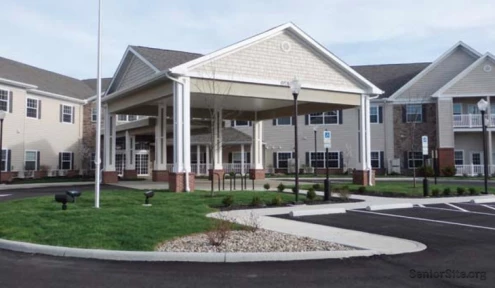Specific dietary choices significantly impact how chronic conditions progress and how well symptoms are managed in seniors, according to recent health studies. Nearly 95% of older adults have at least one chronic condition, with about 80% living with two or more.
Proper nutrition for seniors helps control conditions like hypertension, type 2 diabetes, and dementia. Research shows that key nutrients including protein, omega-3 fatty acids, fiber, calcium, and vitamin D play essential roles in managing these conditions and maintaining overall wellness.
Many seniors report wanting to improve their diets but receive insufficient guidance from healthcare providers. The right nutrition plan requires more than simply eating healthy foods – it demands understanding how specific conditions alter nutritional needs and how to adapt meals accordingly.
This guide examines practical nutrition strategies for seniors with chronic conditions. It covers selecting appropriate foods based on specific health requirements, managing common eating challenges that emerge with age, and establishing sustainable eating routines that support long-term health management.
Understanding Your Condition and Nutritional Needs
Chronic health conditions fundamentally alter how the body processes and utilizes nutrients. These changes become increasingly important for seniors managing ongoing illnesses, as each condition creates specific nutritional demands.
Why chronic conditions change your dietary needs
The relationship between chronic conditions and nutrition works both ways. Poor nutrition can contribute to illness development, while appropriate food choices help manage symptoms and slow disease progression. Nearly 95% of older adults have at least one chronic condition, and approximately 80% live with two or more.
Chronic conditions modify nutritional needs through several mechanisms:
- Altered metabolism: Conditions like diabetes change how the body processes carbohydrates
- Medication interactions: Many prescriptions deplete certain nutrients or alter absorption rates
- Inflammatory responses: Chronic inflammation significantly increases nutritional demands
- Reduced absorption: Digestive system conditions limit nutrient uptake efficiency
Heart disease patients benefit from reduced cholesterol and fat consumption, while diabetes requires careful carbohydrate management. Kidney disease alters protein processing capabilities, and osteoporosis increases requirements for bone-supporting nutrients like calcium and vitamin D.
How to identify condition-specific nutrition goals
Healthcare providers should be the first resource for identifying nutritional needs. Research shows many older adults want to improve their diet but report insufficient counseling from healthcare professionals. Specific questions about how nutrition affects individual conditions often yield valuable guidance.
When establishing condition-specific goals, seniors should consider:
- Protein requirements: Older adults need more protein (approximately 1.0-1.2g/kg body weight daily) to maintain muscle mass, with research suggesting 25-30g per meal for optimal absorption
- Nutrient timing: Spreading protein intake evenly throughout the day improves absorption compared to consuming most at dinner
- Nutrient interactions: Certain conditions benefit from specific nutrient combinations, such as calcium with vitamin D for bone health
- Diet patterns proven for multiple conditions: Mediterranean and DASH dietary approaches benefit several chronic conditions simultaneously
Some conditions require medical nutrition therapy – specialized eating plans developed with healthcare providers. Medically tailored meals have shown effectiveness in managing conditions like heart disease, diabetes, and chronic kidney disease.
Understanding the connection between specific conditions and nutritional requirements empowers seniors to make informed choices that improve quality of life and help manage symptoms effectively.
Building a Balanced Plate for Daily Life
Creating nutritionally complete meals becomes crucial for seniors managing chronic conditions. A strategically structured plate supports ongoing health management while providing essential nutrients for daily functioning.
Choosing the right proteins for strength and healing
Protein maintains muscle mass and supports healing processes in aging bodies. Research indicates older adults need approximately 1-1.2 grams of protein per kilogram of body weight daily. Studies show spreading protein consumption throughout the day improves absorption compared to consuming most at dinner.
Effective protein sources for seniors include:
- Lean meats (chicken, beef, pork) containing iron, zinc, and B vitamins
- Fish (arctic char, cod, halibut) rich in omega-3 fatty acids
- Low-fat dairy products such as cottage cheese (28g protein per cup)
- Plant-based options including tofu, lentils, and chickpeas
Incorporating fiber and whole grains for digestion and energy
Fiber supports digestive health, blood sugar management, and reduces cardiovascular risk. Despite these benefits, 95% of adults fail to consume adequate fiber. Nutritional guidelines recommend whole grains should occupy approximately ¼ of the plate.
Whole grain options produce milder blood sugar responses compared to refined grains while delivering essential B vitamins, iron, and magnesium. Foods like brown rice, oatmeal, quinoa, and barley help lower LDL cholesterol levels and reduce inflammatory markers.
Smart hydration habits for seniors
The National Academy of Medicine (NAM) recommends approximately 13 cups of fluid daily for men and 9 cups for women aged 51+. Despite these guidelines, up to 40% of elderly people remain chronically underhydrated.
Hydration strategies should focus on prevention rather than response to thirst cues. Creating “hydration stations” throughout living spaces makes regular sipping more convenient. Seniors finding plain water unpalatable can add sliced fruits or incorporate milk alternatives, herbal teas, or water-rich foods like watermelon and cucumbers.
Using herbs and spices to reduce salt and sugar
Recent studies demonstrate that strategic use of herbs and spices makes low-salt food equally satisfying as higher-salt versions. Spicy seasonings such as chipotle particularly help mask reduced salt content, while basil, garlic, cinnamon, and vanilla effectively diminish both salt and sugar requirements.
Overcoming Common Eating Challenges in Older Adults
Seniors face distinct nutritional obstacles as they age, yet research shows these barriers can be addressed with targeted strategies that account for physical and sensory changes.
Dealing with appetite loss or taste changes
Between 15-30% of seniors develop what medical experts call “anorexia of aging”. This condition emerges as taste buds decrease in number after age 60 and remaining taste receptors become less responsive. The resulting sensory changes often lead to diminished interest in previously enjoyable foods, particularly nutrient-dense options like fruits and vegetables.
Effective countermeasures include:
- Adding fresh herbs, mild spices, or aromatic ingredients to enhance flavor without increasing salt or sugar content
- Incorporating varied textures and colorful foods to stimulate multiple senses simultaneously
- Managing dry mouth with regular water sips and artificial saliva products when necessary
- Ensuring good oral hygiene and properly fitting dentures for comfortable eating
Making meals easier with limited mobility
Physical limitations create significant barriers to meal preparation but shouldn’t compromise nutritional intake. Studies show that for arthritis and similar mobility-limiting conditions:
- Pre-sliced fruits and vegetables significantly reduce physical strain during meal preparation
- Finger foods like fish strips or vegetable sticks offer independence for those struggling with utensils
- Nutritious soups and smoothies provide complete nutrition for those with chewing difficulties
- Adaptive kitchen tools like electric can openers remove barriers for those with limited hand strength
Family members participating in batch-cooking sessions or meal delivery services can ensure several days of nutritious, ready-to-eat meals.
Eating well on a budget
Fixed incomes present financial challenges but needn’t compromise nutritional quality. Research-backed shopping strategies include:
- Creating weekly meal plans based on sale items and seasonal produce
- Selecting nutrient-dense, affordable foods like beans, lentils, eggs, and canned fish
- Utilizing frozen fruits and vegetables, which maintain nutritional value longer than fresh alternatives
- Accessing community resources such as food banks or senior meal programs
Research consistently shows that social engagement during meals improves both appetite and nutritional intake. Studies indicate seniors eating alone leave approximately 40% of hospital food uneaten, while those dining with companions consume 25% more.
Creating a Sustainable Nutrition Routine
Consistent eating habits prove fundamental for seniors managing chronic conditions. Research shows a structured approach to meals helps maintain nutritional intake and simplifies health management over time.
Meal planning tips for elderly nutrition
Effective meal planning starts with practical preparation strategies. Studies recommend cooking larger portions and freezing individual servings for days when meal preparation becomes challenging. This approach addresses two common problems simultaneously: maintaining nutritional consistency and reducing daily cooking demands.
Kitchen organization significantly impacts nutritional outcomes for seniors:
- Low-sodium frozen or canned vegetables and beans provide convenient nutrient sources
- Frozen fruits or those packed in juice (not syrup) offer ready-to-eat options
- Whole grains like brown rice, oats, and quinoa support long-term dietary consistency
Meal timing and environment play crucial roles beyond food selection itself. Research indicates that skipping meals often leads to excessive hunger and poor food choices later. Social dining environments show remarkable benefits—studies reveal 40% of hospital food goes uneaten when seniors dine alone, while social dining increases consumption by 25%.
How to track progress and adjust over time
Monitoring nutritional intake requires systematic documentation. Food diaries, whether written or digital, provide objective data to share with healthcare providers. These records help identify potential nutrient deficiencies and areas needing improvement.
The complexity of managing multiple conditions demands regular nutritional reassessment. Approximately 80% of seniors live with two or more chronic conditions, each potentially altering nutritional requirements. This makes ongoing evaluation essential.
Effective tracking approaches include:
- Document responses: Recording how specific foods affect individual symptoms
- Schedule regular reviews: Meeting with healthcare providers quarterly to evaluate nutritional strategies
- Remain flexible: Adjusting portions or food choices as health needs evolve
Registered dietitians trained in geriatric nutrition offer specialized guidance beyond what primary care providers typically provide. Many seniors report receiving insufficient nutritional counseling from their regular healthcare providers, making specialist input particularly valuable.
Thoughtful planning combined with consistent monitoring transforms nutrition from a temporary intervention into a sustainable practice supporting long-term health management.
Conclusion
Research consistently demonstrates that appropriate nutrition significantly impacts symptom management and quality of life for seniors with chronic conditions. Multiple studies show dietary choices directly affect disease progression and daily functioning across various health conditions.
Effective nutritional management requires understanding condition-specific needs rather than following generic healthy eating guidelines. The evidence indicates that tailored approaches addressing individual health challenges yield better outcomes than one-size-fits-all recommendations.
Seniors benefit most from practical, incremental changes to eating habits. Starting with one or two strategies from this guide typically proves more successful than attempting complete dietary overhauls. Regular consultation with healthcare providers ensures nutritional approaches remain appropriate as health needs evolve.
Approximately 80% of seniors live with two or more chronic conditions, making individualized nutrition planning especially important. Research shows many older adults want to improve their diets but report insufficient guidance from healthcare providers, highlighting the value of seeking specialized nutritional counseling.
The most effective nutritional approaches balance scientific evidence with practical implementation. Studies consistently show that sustainable dietary changes depend on addressing real-world challenges like budget limitations, mobility issues, and changing taste preferences.
Thoughtful meal planning combined with regular monitoring transforms nutrition from a burdensome task into an effective health management tool. This approach helps seniors maintain independence and improve quality of life while managing chronic health conditions.
FAQs
Q1. How does nutrition impact chronic conditions in seniors? Proper nutrition plays a crucial role in managing chronic conditions for seniors. A well-balanced diet can help control symptoms, slow disease progression, and improve overall quality of life. Specific nutrients can address the unique needs of different conditions, such as reducing cholesterol for heart disease or managing carbohydrates for diabetes.
Q2. What are some easy ways for seniors to increase their protein intake? Seniors can boost their protein intake by incorporating lean meats, fish, low-fat dairy products, and plant-based options like tofu and legumes into their meals. It’s recommended to spread protein consumption throughout the day, aiming for 25-30g per meal for optimal absorption. Protein shakes or smoothies can also be convenient options.
Q3. How can seniors overcome appetite loss and taste changes? To combat appetite loss and taste changes, seniors can try enhancing flavors with herbs and spices, focusing on varied textures and colorful foods, and addressing dry mouth issues. Maintaining good oral health and ensuring properly fitting dentures are also important. Additionally, sharing meals with others can improve both appetite and enjoyment of food.
Q4. What are some budget-friendly nutrition tips for seniors? Seniors can eat well on a budget by planning meals around sale items and seasonal produce, choosing nutrient-dense affordable foods like beans and eggs, opting for frozen fruits and vegetables, and exploring community resources such as food banks or senior meal programs. Creating a weekly meal plan can also help manage costs effectively.
Q5. How often should seniors review their nutrition plan with healthcare providers? Seniors should aim to review their nutrition plan with healthcare providers regularly, ideally on a quarterly basis. This allows for timely adjustments based on changing health needs and ensures the plan remains effective for managing chronic conditions. Keeping a food diary and noting how different foods affect symptoms can provide valuable insights during these reviews.












